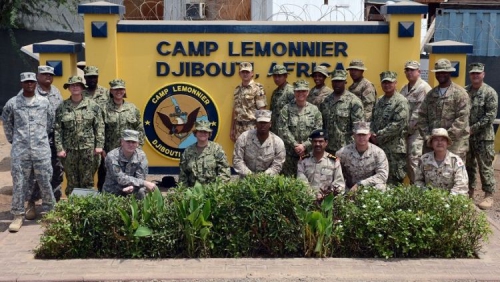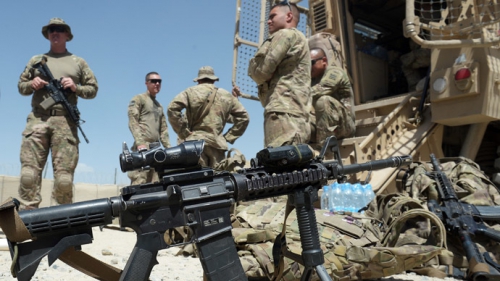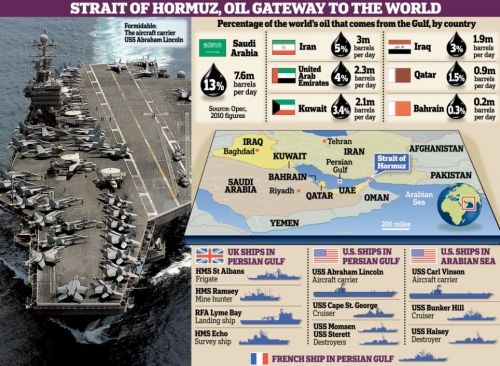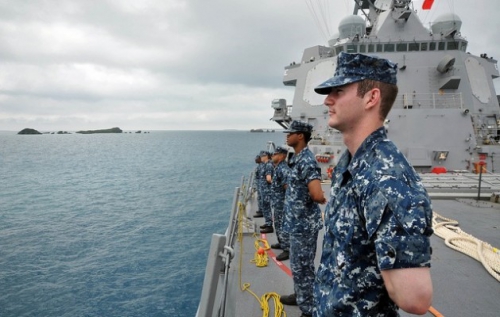lundi, 24 novembre 2014
Au coeur du nationalisme ukrainien
00:10 Publié dans Actualité, Affaires européennes, Entretiens, Géopolitique | Lien permanent | Commentaires (0) | Tags : politique internationale, géopolitique, ukraine, europe, affaires européennes, eurasisme, eurasie, donbass |  |
|  del.icio.us |
del.icio.us |  |
|  Digg |
Digg | ![]() Facebook
Facebook
Hungary’s Viktor Orban: Washington’s New Enemy Image
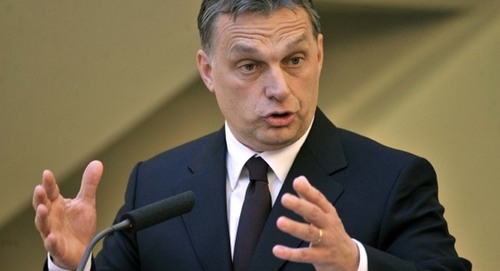
Hungary’s Viktor Orban: Washington’s New Enemy Image
Hungary and its populist nationalist Prime Minister Viktor Orban have come into the cross-hairs of Washington’s political elites. His sin? Not buckling under to the often destructive diktats of the Brussels EU Commission; attempting to define a Hungarian national identity. But his cardinal sin is his deepening relationship with Russia and his defiance of Washington in signing an agreement with Gazprom for bringing the Russian South Stream gas pipeline into the EU via Hungary.
Orban has himself undergone a political journey since he was elected as Hungary’s second-youngest Prime Ministers in 1998. Back then he oversaw the entry of Hungary along with Poland and the Czech Republic into NATO over Russia’s protest, and into the EU. As Prime Minister during far more prosperous economic times in the EU, Orban cut taxes, abolished university tuition for qualified students, expanded maternity benefits, and attracted German industry with low-cost Hungarian labor. One of his American “advisers” then was James Denton, linked with the Color Revolution Washington NGO, Freedom House. Orban seemed the darling of Washington’s neo-cons. In 2001 he was given the neoconservative American Enterprise Institute’s Freedom Award.
But in 2010 after six years in the opposition, Orban returned, this time with a resounding majority for his Fidesz-Hungarian Civic Union Party, Fidesz for short. In fact Fidesz won a 68% supermajority in Parliament, giving it the necessary votes to alter the Constitution and pass new laws, which it did. Ironically, in a case of the pot calling the kettle black, the United States Obama Administration and the European Parliament for placing too much power in the hands of Fidesz. Orban was accused by Daniel Cohn-Bendit of the European Greens of making Hungary on the model of Venezuela’s Hugo Chavez. He was definitely not playing by the approved Brussels Rulebook for politically submissive EU politicians. Fidesz began to be demonized in EU media as the Hungarian version of United Russia and Orban as the Hungarian Putin. That was in 2012.
Now its getting alarming for the Atlanticists and their EU followers. Orban has defied EU demands to stop construction of Russia’s important South Stream gas pipeline.

Russia’s South Stream gas pipeline would guarantee EU gas together with German-Russian Nord Stream that could bypass the war in Ukraine something Washington bitterly opposes for obvious reasons
Last January Orban’s government announced a € 10 billion deal with the Russian state nuclear energy company to refurbish Hungary’s only nuclear power plant at Paks, originally built during the Soviet era with Russian technology.
That caused some attention in Washington. Similarly when Orban criticized the United States this past summer for failing to ultimately resolve the global financial crisis its banks and its lax regulation caused, and praised China, Turkey and Russia as better models. He declared in words not too different from what I have often used that Western democracies, “will probably be incapable of maintaining their global competitiveness in the upcoming decades and will instead be scaled down unless they are capable of changing themselves significantly.” In addition, Orban’s government managed to free Hungary from decades of devastating IMF bondage. In August 2013, the Hungarian Economic Ministry announced that it had, thanks to a “disciplined budget policy,” repaid the remaining €2.2 billion owed to the IMF. No more onerous IMF-forced state privatizations or conditionalities. The head of the Hungarian Central Bank then demanded the IMF close its offices in Budapest. In addition, echoing Iceland, the State Attorney General brought charges against the country’s three previous prime ministers because of the criminal amount of debt into which they plunged the nation. That’s a precedent that surely causes cold sweat in some capitals of the EU or Washington and Wall Street.
But the real alarm bells rang when Orban and his Fidesz party approved a go-ahead, together with neighboring Austria, of the South Stream Russian pipeline, ignoring EU claims it violated EU rules. Orben proclaimed at a meeting with Germany’s Horst Seehofer in Munich on November 6, “”Es lebe die österreichisch-ungarische Energiemonarchie” („The Austro-Hungarian Energy Monarchy Lives.“)
The US elites sounded the alarm immediately. The ultra-establishment New York Times ran a lead editorial, “Hungary’s Dangerous Slide.” They declared, “The government of Prime Minister Viktor Orban of Hungary is sliding toward authoritarianism and defying the fundamental values of the European Union — and getting away with it.”
The Times revealed the real cause of Washington and Wall Street alarm: “Hungary’s most recent expression of contempt for the European Union is its passage of a law on Monday that clears the way for Russia’s South Stream natural gas pipeline to traverse Hungary. The new law is in clear violation of the European Parliament’s call in September for member states to cancel South Stream, and of the economic sanctions against Russia imposed by the European Union and the United States after Russia’s actions in Ukraine. Instead of issuing tepid expressions of concern over antidemocratic policies, the European Union should be moving to sanction Hungary. Jean-Claude Juncker, the president of the European Commission, should exercise his power to force Mr. Navracsics to resign.” Tibor Navracsics, has just been named the new European Commissioner of Education, Culture, Youth and Sport, a post in Brussels that has arguably little to do with gas pipelines.
Next we can expect the National Endowment for Democracy and the usual US Government-backed NGO’s to find an excuse to launch mass opposition protests against Fidesz and Orban for his unforgivable crime of trying to make Hungary’s energy independent of the US-created insanity in Ukraine.
F. William Engdahl is strategic risk consultant and lecturer, he holds a degree in politics from Princeton University and is a best-selling author on oil and geopolitics, exclusively for the online magazine “New Eastern Outlook”
First appeared: http://journal-neo.org/2014/11/21/hungary-s-viktor-orban-washington-s-new-enemy-image/
00:05 Publié dans Actualité, Affaires européennes, Géopolitique | Lien permanent | Commentaires (0) | Tags : south stream, politique internationale, gazoducs, hydrocarbures, énergie, europe, affaires européennes, hongrie, mitteleuropa, europe centrale, europe danubienne, russie |  |
|  del.icio.us |
del.icio.us |  |
|  Digg |
Digg | ![]() Facebook
Facebook
Sinterklaas en Zwarte Piet verschillend, maar vullen elkaar perfect aan
'Sinterklaas en Zwarte Piet verschillend, maar vullen elkaar perfect aan'
Een gesprek met literatuurwetenschapper Rita Ghesquiere
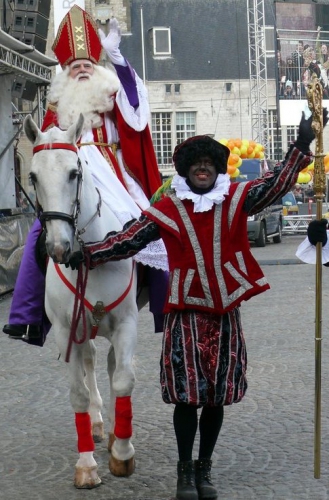 In 1989 verscheen bij het Davidsfonds het boek 'Van Nicolaas van Myra tot Sinterklaas. De kracht van een verhaal.' Het was een uitgebreide studie naar de oorsprong van het kinderfeest. Doorbraak vond het tijd - gezien het heersende debat over Zwarte Piet - om even met de auteur, professor Rita Ghesquiere, te praten.
In 1989 verscheen bij het Davidsfonds het boek 'Van Nicolaas van Myra tot Sinterklaas. De kracht van een verhaal.' Het was een uitgebreide studie naar de oorsprong van het kinderfeest. Doorbraak vond het tijd - gezien het heersende debat over Zwarte Piet - om even met de auteur, professor Rita Ghesquiere, te praten.
Doorbraak: Sinds kort laait het in Nederland al oudere debat over het vermeende racistische karakter van Zwarte Piet ook in Vlaanderen op. Houdt het argument dat Zwarte Piet een veruiterlijking is van een koloniaal denken volgens u steek?
Rita Ghesquiere: 'Sinterklaas en Zwarte Piet zijn complexe figuren. Hun ontstaansgeschiedenis reikt veel verder dan de periode van de kolonisatie. Er zijn bovendien verschillende interpretaties en duidingen. Allebei de figuren hebben een ambigu karakter waarin positieve en negatieve elementen verwerkt zijn. Reeds in de oudste legende 'Het verhaal van de drie veldheren' spreekt een toornige Nicolaas dreigende taal tegen de keizer. In de legende van Crux gebruikt Nicolaas de roede. Verschillende oude legenden voeren Nicolaas ook op als 'duivelbezweerder'. Die gedachte wordt nog versterkt in het inculturatieproces waarbij het christendom oude bestaande mythen en rituelen opneemt. Nicolaas als winterheilige krijgt dan aspecten van de Germaanse god Wodan die zowel beschermend als bedreigend is. Guido Gezelle spreekt van 'Klaai den duvele' en verwijst naar de Engelse uitdrukking Old Nick een synoniem voor de duivel. Zwarte Piet is vanuit dat oogpunt de verslagen en bekeerde 'demon' die op zijn beurt positieve en negatieve elementen in zich draagt. De roede of gard is oorspronkelijk een positief symbool. Wie er door aangeraakt wordt, krijgt levenskracht en geluk. Die invulling van Sinterklaas als winterheilige en gever met schaduwfiguur of knecht vinden we alleen in Noord-Europa.
In de Nederlandse kinderliteratuur vanaf de negentiende eeuw worden beide figuren meer als tegenpolen voorgesteld, al vraagt ook dat nuancering. In het bekende boek van Schenkman Sint Nicolaas en zijn knecht zien we dat Sint Nicolaas zelf de zak in zijn hand houdt en de kinderen streng vermanend aankijkt. De tekst luidt:
Ei, ei die Sint Niklaas is lang toch niet mak!
Daar stopt hij twee knaapjes pardoes in zijn zak.
't is loon vast naar werken en rijklijk verdiend.
Hij straft niet graag kinderen, maar is hun vriend.
O bisschop, vergeef hun deez' enkele keer.
Schenk, schenk hun genade, zij doen het nooit meer!
In de uitgave van Bom van hetzelfde boek, rijden zowel de Sint als Piet op een paard over het dak. Ook toen al was er dus een vorm van gelijkwaardigheid. Beide figuren evolueren mee met de tijdgeest. Pedagogische bezwaren zorgden ervoor dat het bestraffende aspect verdween. De secularisatie ontnam Nicolaas zijn heiligheid, de knecht zijn duister verleden. De laatste decennia is de Sint eerder een lieve oude opa. 'Er zijn geen stoute kinderen' wordt jaar na jaar herhaald. Dat geldt evenzeer voor Zwarte Piet. Hij is niet langer de dreigende helper, maar de medeorganisator van het feest. Vaak krijgt hij zelfs de leidende rol, omdat de Sint als oud, ziek en moe voorgesteld wordt.
Zwarte Piet reduceren tot een veruiterlijking van het koloniale denken is dus een sterke vereenvoudiging, die ook na analyse niet helemaal klopt. De religieuze duiding biedt meer en beter houvast. maar er duiken nog andere denkpistes op. Arno Langeler verbindt in zijn boek Zwarte Piet uit 1994 de figuur van Zwarte Piet met Cristoforo Moro, een historische figuur uit een illustere familie die een dubbelzinnige rol speelde tijdens de strijd om Cyprus in 1570-'71. Helemaal geen slaaf dus maar een machtige man met Afrikaanse roots van wie de stamboom teruggaat tot de Romeinse tijd.
Opvallend is ook dat dit duo Sinterklaas en Piet niet bekend is in de Zuiderse Europese landen zoals Spanje en Portugal, twee van oorsprong katholieke landen met een sterk koloniaal verleden. We vinden ze wel terug in ondermeer Nederland, Duitsland, Luxemburg, het Noorden van Frankrijk, Oostenrijk, Zwitserland en Tsjechië. Dat wijst erop dat elementen uit de Germaanse cultuur in de beeldvorming een belangrijke rol gespeeld hebben.'
Is Zwarte Piet dan niet ‘racistisch’?
'Racistisch staat voor de opvatting dat het ene ras superieur is aan het andere en uit de discriminatie die daarvan het gevolg is. Sinterklaas en Zwarte Piet zijn verschillend, maar vullen elkaar perfect aan.
Bovendien horen Sinterklaas en Zwarte Piet op de eerste plaats thuis in een mythisch denken, niet in het rationele zintuiglijke denken. Het rationele denken maakt immers een einde aan het geloof in sinterklaas. Het mythisch denken confronteert ons met een andere onzichtbare, transcendente werkelijkheid. Het onzichtbare, de nacht en het andere spelen daarin een rol omdat juist de Unheimlichkeit de grens tussen de werkelijkheid en de onwerkelijkheid opheft. Natuurlijk hebben verhalen ook een maatschappelijke relevantie omdat ze bijvoorbeeld morele waarden en pedagogische opvattingen bevatten.
Op zoek naar de wortels van beide figuren zien we hoe er op een bepaald moment een zekere polarisatie ontstaat, maar nauwkeurige analyse van teksten en prenten toont meer dubbelzinnigheid.
Tot in de jaren zestig werd Piet als de ondergeschikte van de Sint voorgesteld soms met negatieve trekken of dreigend. Analyse van de recente kinderliteratuur laat zeer duidelijk zien dat Zwarte Piet is geëvolueerd tot een uitgesproken positief personage, een spilfiguur die het feest mee draagt. Een grootschalig onderzoek in Nederland van Gábor Kozijn in 2014 toont aan dat meer dan 90 procent van de volwassenen en de kinderen Zwarte Piet niet als racistisch ervaart, maar de figuur inderdaad een positief imago toekent 'leuk', grappig' en 'slim'. Het oordeel van Amsterdammers verschilt in die zin dat daar een grote minderheid de figuur als discriminerend ervaart. Bij de tegenstanders zetten vooral Surinamers en Ghanezen de toon. Opvallend is dat zij Zwarte Piet niet discriminerend vinden voor zichzelf maar voor andere. Het gaat dus veeleer om een principiële houding die niet steunt op kennis van de verhalen. Maar de confrontatie met de perceptie en/of de gevoelens is geen gemakkelijke zaak.
Geregeld duikt er ook kritiek op vanuit feministische hoek. Feministen vinden het discriminerend dat de wereld van Sinterklaas vooral een mannenzaak is. Dat soort ongenoegen wekt doorgaans weinig sympathie. Positiever is het pleidooi om alert te zijn bijvoorbeeld voor de stereotiepen in het speelgoed; Dat geldt ook voor racisme. Racistische voorstellingen van Zwarte Piet, zoals lui of dom, moeten terecht geweerd worden uit de kinderliteratuur en andere cultuurproducten.'
Staat de ‘roetveegpiet’ dichter bij het origineel dan onze huidige Zwarte Piet met de rode lippen en de zwarte krullen?
'De roetveegpiet die alleen maar zwart wordt door zijn werk in de schoorsteen sluit inderdaad nauwer aan bij wat we terugvinden in de Germaanse cultuur waar de schoorsteen als verbinding met de godenwereld een belangrijke rol speelt. In de haard laat men de gaven achter - de laatste schoof, de laatste vruchten van het veld - om de goden goed te stemmen.
In Nederland duikt de Zwarte Piet in pagekledij met zwarte krullen, rode lippen en soms oorbellen en witte kraag veel vroeger op dan in Vlaanderen. Felix Timmermans tekent Zwarte Piet bijvoorbeeld als een arme zwerver. Uitwisseling van kinderboeken en televisieprogramma's zorgden er echter voor dat de Nederlandse invulling van de knecht steeds dominanter werd ook in Vlaanderen. 'De kleren maken de man', geldt voor sinterklaas - mijter, staf, rode mantel enz. - en dat geldt ook steeds vaker voor Piet. Hier past evenwel een belangrijke kanttekening. In de recente kinderliteratuur is het beeld van Piet of de pieten overwegend positief, welk pak hij ook draagt.'
Heeft u weet van hoe men in Franstalig België omgaat met de knecht van de Sint?
'Niet echt; Ik merk op internet dat père fouettard zoals hij in Franstalig België genoemd wordt, veel minder prominent aanwezig is. Er is ook geen spoor van discussie of debat, met uitzondering van een krantenartikel over de rellen in Gouda. Sinterklaas woont volgens het postadres dat via internet verspreid wordt - Rue du Paradis, 0612 Ciel - nog steeds in de hemel en hij rijdt ook op een ezel. Vlaanderen leunt dus onder invloed van sinterklaasliedjes, -boeken en -films dichter aan bij Nederland.
Wel herinner ik mij wel hoe de Franstalige studenten aan het einde van de jaren zestig in Leuven uitbundig het sinterklaasfeest vierden. Ze waren verkleed als Sint met lange witte labojassen, nepbaarden en papieren mijters, terwijl ze rondgereden werden op carnavalwagens en zich bezondigden aan overmatig drankgebruik. Een weinig verheffend beeld van de 'goedheiligman' vooral voor de kinderen die dit schouwspel moesten gadeslaan. Die vorm van Sinterklaasfeest is totaal onbekend in Vlaanderen. Later ontdekte ik dat deze invulling eveneens diepe wortels heeft. Vanaf de middeleeuwen was Nicolaas immers de patroon van de studenten en dat patroonsfeest werd en wordt nog steeds luidruchtig en op studentikoze wijze gevierd.'
Sommige gemeenten in Nederland schaffen hun intochten af uit schrik voor geweld. Heeft het sinterklaasfeest zoals we dat nu kennen nog een toekomst?
'Het grootschalig onderzoek in Nederland van Gábor Kozijn in 2014 laat zien dat er wel degelijk een toekomst is voor het feest. Toch vind ik persoonlijk dat een zekere soberheid het sinterklaasgebeuren ten goede zou komen. Als de geschenken wat bescheidener worden, dan kan de Sint misschien ook met minder helpers aan de slag, met minder grote sinthuizen, met minder op- en intochten... Een bescheidener feest zal minder aanstoot geven aan wie niet wil meevieren.'
U schreef uw boek in 1989, voor het televisieprogramma ‘Dag Sinterklaas’, dat toch wel betekenend is geweest voor het sinterklaasfeest in Vlaanderen. Merkt u vandaag een andere manier van Sinterklaas vieren op dan dertig jaar geleden?
'Mijn eerste indruk is dat er inderdaad wat meer luister en vertoon is in de publieke ruimte met bijvoorbeeld in verschillende steden intochten of een 'huis van de Sint'. In de gezinnen en de scholen is er niet zo veel veranderd. Het geloof is eerder toegenomen. Bij mijn kinderen, vooral jaren 1980, hield het slechts stand tot de eerste of tweede klas. In de volgende generatie zie ik oprecht en soms hardnekkig geloof ook bij oudere kinderen. De televisieserie Dag Sinterklaas enfilms als Het paard van Sinterklaas of hyperrealistische prentenboeken geven voeding aan dat geloof. De gezinnen vieren het sinterklaasfeest met dezelfde rituelen, bijvoorbeeld schoenzetten, samen de trap af, zingen.'
Klopt de stelling dat de Vlaamse Sint ‘katholieker’ is dan zijn Nederlandse versie?
'Dat was zeker zo tot in de jaren zestig en wellicht kleurt het ook nu nog onbewust de voorstelling. In Franstalig België is de Sint nog duidelijk 'katholieker'. Het protestantisme en de secularisatie hebben in Nederland veel eerder de religieuze aspecten van de sinterklaasfiguur uitgegomd. In Engeland verdween het sinterklaasfeest volledig.'
Is de tijd nu rijp voor een herwerkte versie van uw boek? Het lijkt actueler dan ooit.
'Misschien wel. Ik blijf de studies en de kinderliteratuur over Sint-Nicolaas aandachtig volgen. Een nieuwe uitgave is echter vooral een zaak van de uitgever en daar zie ik voorlopig geen belangstelling.'
Ten slotte: staat uw schoen al klaar?
'Mijn schoen staat niet klaar, maar ik verwacht de Sint en Piet wel voor een bezoek aan huis waar we samen met onze kinderen en kleinkinderen naar uitkijken.'
Mevrouw Ghesquiere gaf nog volgende bronnen mee:
Gábor Kozijn, Verkennend Onderzoek naar een toekomstbestendig Sinterklaasfeest. Den Haag, 2014.
Pieter van der Ree, Sinterklaas en het geheim van de nacht. Zeist, 2012.
Louis Janssen, Nicolaas, de duivel en de doden. Utrecht, 1993.
Arno Langeler, Zwarte Piet. Amsterdam, 1994.
Rita Ghesquiere, Van Nicolaas van Myra tot Sinterklaas. Leuven, 1989
00:05 Publié dans Entretiens, Traditions | Lien permanent | Commentaires (0) | Tags : saint nicolas, zwarte piet, folklore, flandre, traditions, entretien, anthropologie, ethnologie |  |
|  del.icio.us |
del.icio.us |  |
|  Digg |
Digg | ![]() Facebook
Facebook
Le devoir d’insurrection
Entretien avec Bernard Plouvier, auteur du "Devoir d’insurrection ou la réponse géopolitique à la tentation cosmopolite"
Propos recueillis par Fabrice Dutilleul
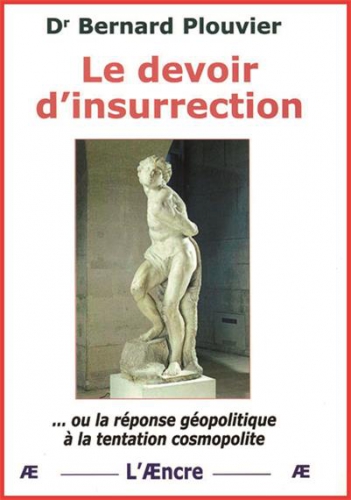 Fabrice Dutilleul : Pourquoi considérez-vous l’insurrection comme un devoir ?
Fabrice Dutilleul : Pourquoi considérez-vous l’insurrection comme un devoir ?
Bernard Plouvier : Mai 2013 : la France est riche de 4,4 millions de chômeurs. Elle est envahie par 11 millions d’immigrés extra-européens et leurs descendants, citoyens français par « droit du sol », dont 10 millions de musulmans, formant une très puissante 5e colonne en cas de guerre civile déclenchée par les islamistes, en relais de la guérilla qui hante nos villes depuis plus de quarante ans, où l’on comptabilise un millier de « zones de non-droit ». Mai 2013, des émeutiers noirs et maghrébins saccagent en état de quasi impunité le centre de Paris et celui de Stockholm ; deux islamistes surarmés tuent un soldat britannique désarmé en plein cœur de Londres et, à Perpignan, 16 islamistes forcent deux autochtones à hurler « Allah Akbar » pour éviter l’émasculation. Pendant ce temps, le Parlement français vote, toutes affaires cessantes, une loi autorisant le mariage des homosexuels, brisant une valeur plurimillénaire, celle de la Famille… et les CRS du ministre de l’Intérieur, qui n’osent guère frapper les émeutiers d’origine extra-européenne, par peur de l’accusation rituelle de « racisme », cognent avec ardeur sur des citoyens et des citoyennes dont le double tort est d’être attachés aux valeurs saines, mais jugées « réactionnaires » et d’être blancs.Tout comme, en ce joli mois de mai 2013, un ministre « socialiste » juge inutile de plafonner les énormes rémunérations des grands patrons, mais le Parlement légifère pour supprimer le mot « race » !
L’état des lieux de l’Europe occidentale que vous dressez est assez peu réjouissant…
On peut abonder dans mon sens ou combattre mes opinions, mais il est nécessaire de s’informer avant d’argumenter. J’étudie le rôle théorique de l’État et la notion, concrète et un peu trop oubliée de nos jours, de « pacte social », et présente la préhistoire de la mondialisation de la vie politique, sociale et culturelle, et celle de la globalisation de l’économie. Cette évocation historique éclaire indéniablement nombre d’aspects de notre époque, qui en devient plus compréhensible. Il en va de même avec l’étude de la manipulation des mouvements islamistes par les USA, envisagée comme une nouvelle arme anti-européenne.
Les apports et coûts de l’immigration extra-européenne sont exposés à la façon d’un bilan…
Oui, ce qui permet au lecteur d’alimenter sa réflexion. De même, sont analysés les tics de langage et les attitudes des politiciens et des agents des media… et là encore, il y a de quoi nourrir les méditations du lecteur. La démission des Européens, dans leur rôle de civilisateurs, est analysée par l’abord des changements d’attitudes (ou d’habitudes) sociales qui font du XXIe siècle, débuté entre 1985 et 1990, une époque radicalement différente du XXe siècle. Il en résulte une incompréhension totale (qui diffère beaucoup du simple et classique « conflit de générations »), entre adolescents ou adultes de moins de quarante ans d’une part et ceux qui ont connu « autre chose », en se souvenant que l’histoire n’enseigne que peu de vérités, mais essentielles : ce qui a été sera de nouveau et aucun changement n’est jamais irréversible.C’est d’une révolution (un terme sur la définition duquel il convient de s’entendre) qu’il s’agit d’envisager… quand s’effritera l’édifice économique, fondé sur le surendettement collectif, l’obsolescence dirigée et la désindustrialisation de l’Europe.
Le devoir d’insurrection ou la réponse géopolitique à la tentation cosmopolite du Dr Bernard Plouvier, collection « Vérités pour l’Histoire », dirigée par Philippe Randa, 346 pages, 33 euros
00:05 Publié dans Actualité, Affaires européennes, Entretiens | Lien permanent | Commentaires (0) | Tags : bernard plouvier, entretien, france, europe, affaires européennes |  |
|  del.icio.us |
del.icio.us |  |
|  Digg |
Digg | ![]() Facebook
Facebook
A Permanent Infrastructure for Permanent War
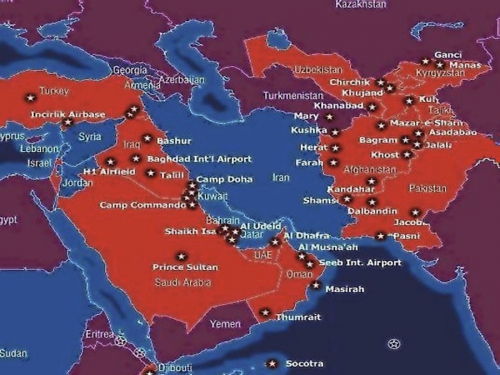
In a September address to the United Nations General Assembly, President Barack Obama spoke forcefully about the “cycle of conflict” in the Middle East, about “violence within Muslim communities that has become the source of so much human misery.” The president was adamant: “It is time to acknowledge the destruction wrought by proxy wars and terror campaigns between Sunni and Shia across the Middle East.” Then with hardly a pause, he went on to promote his own proxy wars (including the backing of Syrian rebels and Iraqi forces against the Islamic State), as though Washington’s military escapades in the region hadn’t stoked sectarian tensions and been high-performance engines for “human misery.”
Not surprisingly, the president left a lot out of his regional wrap-up. On the subject of proxies, Iraqi troops and small numbers of Syrian rebels have hardly been alone in receiving American military support. Yet few in our world have paid much attention to everything Washington has done to keep the region awash in weaponry.
Since mid-year, for example, the State Department and the Pentagon have helped pave the way for the United Arab Emirates (UAE) to buy hundreds of millions of dollars worth of High Mobility Artillery Rocket Systems (HIMARS) launchers and associated equipment and to spend billions more on Mine Resistant Ambush Protected (MRAP) vehicles; for Lebanon to purchase nearly $200 million in Huey helicopters and supporting gear; for Turkey to buy hundreds of millions of dollars of AIM-120C-7 AMRAAM (Air-to-Air) missiles; and for Israel to stock up on half a billion dollars worth of AIM-9X Sidewinder (air-to-air) missiles; not to mention other deals to aid the militaries of Egypt, Kuwait, and Saudi Arabia.
For all the news coverage of the Middle East, you rarely see significant journalistic attention given to any of this or to agreements like the almost $70 million contract, signed in September, that will send Hellfire missiles to Iraq, Jordan, Saudi Arabia, and Qatar, or the $48 million Navy deal inked that same month for construction projects in Bahrain and the UAE.
The latter agreement sheds light on another shadowy, little-mentioned, but critically important subject that’s absent from Obama’s scolding speeches and just about all news coverage here: American bases. Even if you take into account the abandonment of its outposts in Iraq -- which hosted 505 U.S. bases at the height of America’s last war there -- and the marked downsizing of its presence in Afghanistan -- which once had at least 800 bases (depending on how you count them) -- the U.S. continues to garrison the Greater Middle East in a major way. As TomDispatch regular David Vine, author of the much-needed, forthcoming book Base Nation: How U.S. Military Bases Overseas Harm America and the World, points out in his latest article, the region is still dotted with U.S. bases, large and small, in a historically unprecedented way, the result of a 35-year-long strategy that has been, he writes, “one of the great disasters in the history of American foreign policy.” That’s saying a lot for a nation that’s experienced no shortage of foreign policy debacles in its history, but it’s awfully difficult to argue with all the dictators, death, and devastation that have flowed from America’s Middle Eastern machinations. Nick Turse
The Bases of War in the Middle East
From Carter to the Islamic State, 35 Years of Building Bases and Sowing DisasterBy David Vine
With the launch of a new U.S.-led war in Iraq and Syria against the Islamic State (IS), the United States has engaged in aggressive military action in at least 13 countries in the Greater Middle East since 1980. In that time, every American president has invaded, occupied, bombed, or gone to war in at least one country in the region. The total number of invasions, occupations, bombing operations, drone assassination campaigns, and cruise missile attacks easily runs into the dozens.
As in prior military operations in the Greater Middle East, U.S. forces fighting IS have been aided by access to and the use of an unprecedented collection of military bases. They occupy a region sitting atop the world’s largest concentration of oil and natural gas reserves and has long been considered the most geopolitically important place on the planet. Indeed, since 1980, the U.S. military has gradually garrisoned the Greater Middle East in a fashion only rivaled by the Cold War garrisoning of Western Europe or, in terms of concentration, by the bases built to wage past wars in Korea and Vietnam.
In the Persian Gulf alone, the U.S. has major bases in every country save Iran. There is an increasingly important, increasingly large base in Djibouti, just miles across the Red Sea from the Arabian Peninsula. There are bases in Pakistan on one end of the region and in the Balkans on the other, as well as on the strategically located Indian Ocean islands of Diego Garcia and the Seychelles. In Afghanistan and Iraq, there were once as many as 800 and 505 bases, respectively. Recently, the Obama administration inked an agreement with new Afghan President Ashraf Ghani to maintain around 10,000 troops and at least nine major bases in his country beyond the official end of combat operations later this year. U.S. forces, which never fully departed Iraq after 2011, are now returning to a growing number of bases there in ever larger numbers.
In short, there is almost no way to overemphasize how thoroughly the U.S. military now covers the region with bases and troops. This infrastructure of war has been in place for so long and is so taken for granted that Americans rarely think about it and journalists almost never report on the subject. Members of Congress spend billions of dollars on base construction and maintenance every year in the region, but ask few questions about where the money is going, why there are so many bases, and what role they really serve. By one estimate, the United States has spent $10 trillion protecting Persian Gulf oil supplies over the past four decades.
Approaching its 35th anniversary, the strategy of maintaining such a structure of garrisons, troops, planes, and ships in the Middle East has been one of the great disasters in the history of American foreign policy. The rapid disappearance of debate about our newest, possibly illegal war should remind us of just how easy this huge infrastructure of bases has made it for anyone in the Oval Office to launch a war that seems guaranteed, like its predecessors, to set off new cycles of blowback and yet more war.
On their own, the existence of these bases has helped generate radicalism and anti-American sentiment. As was famously the case with Osama bin Laden and U.S. troops in Saudi Arabia, bases have fueled militancy, as well as attacks on the United States and its citizens. They have cost taxpayers billions of dollars, even though they are not, in fact, necessary to ensure the free flow of oil globally. They have diverted tax dollars from the possible development of alternative energy sources and meeting other critical domestic needs. And they have supported dictators and repressive, undemocratic regimes, helping to block the spread of democracy in a region long controlled by colonial rulers and autocrats.
After 35 years of base-building in the region, it’s long past time to look carefully at the effects Washington’s garrisoning of the Greater Middle East has had on the region, the U.S., and the world.
“Vast Oil Reserves”
While the Middle Eastern base buildup began in earnest in 1980, Washington had long attempted to use military force to control this swath of resource-rich Eurasia and, with it, the global economy. Since World War II, as the late Chalmers Johnson, an expert on U.S. basing strategy, explained back in 2004, “the United States has been inexorably acquiring permanent military enclaves whose sole purpose appears to be the domination of one of the most strategically important areas of the world.”
In 1945, after Germany’s defeat, the secretaries of War, State, and the Navy tellingly pushed for the completion of a partially built base in Dharan, Saudi Arabia, despite the military’s determination that it was unnecessary for the war against Japan. “Immediate construction of this [air] field,” they argued, “would be a strong showing of American interest in Saudi Arabia and thus tend to strengthen the political integrity of that country where vast oil reserves now are in American hands.”
By 1949, the Pentagon had established a small, permanent Middle East naval force (MIDEASTFOR) in Bahrain. In the early 1960s, President John F. Kennedy’s administration began the first buildup of naval forces in the Indian Ocean just off the Persian Gulf. Within a decade, the Navy had created the foundations for what would become the first major U.S. base in the region -- on the British-controlled island of Diego Garcia.
In these early Cold War years, though, Washington generally sought to increase its influence in the Middle East by backing and arming regional powers like the Kingdom of Saudi Arabia, Iran under the Shah, and Israel. However, within months of the Soviet Union’s 1979 invasion of Afghanistan and Iran’s 1979 revolution overthrowing the Shah, this relatively hands-off approach was no more.
Base Buildup
In January 1980, President Jimmy Carter announced a fateful transformation of U.S. policy. It would become known as the Carter Doctrine. In his State of the Union address, he warned of the potential loss of a region “containing more than two-thirds of the world’s exportable oil” and “now threatened by Soviet troops” in Afghanistan who posed “a grave threat to the free movement of Middle East oil.”
Carter warned that “an attempt by any outside force to gain control of the Persian Gulf region will be regarded as an assault on the vital interests of the United States of America.” And he added pointedly, “Such an assault will be repelled by any means necessary, including military force.”
With these words, Carter launched one of the greatest base construction efforts in history. He and his successor Ronald Reagan presided over the expansion of bases in Egypt, Oman, Saudi Arabia, and other countries in the region to host a “Rapid Deployment Force,” which was to stand permanent guard over Middle Eastern petroleum supplies. The air and naval base on Diego Garcia, in particular, was expanded at a quicker rate than any base since the war in Vietnam. By 1986, more than $500 million had been invested. Before long, the total ran into the billions.
Soon enough, that Rapid Deployment Force grew into the U.S. Central Command, which has now overseen three wars in Iraq (1991-2003, 2003-2011, 2014-); the war in Afghanistan and Pakistan (2001-); intervention in Lebanon (1982-1984); a series of smaller-scale attacks on Libya (1981, 1986, 1989, 2011); Afghanistan (1998) and Sudan (1998); and the "tanker war" with Iran (1987-1988), which led to the accidental downing of an Iranian civilian airliner, killing 290 passengers. Meanwhile, in Afghanistan during the 1980s, the CIA helped fund and orchestrate a major covert war against the Soviet Union by backing Osama Bin Laden and other extremist mujahidin. The command has also played a role in the drone war in Yemen (2002-) and both overt and covert warfare in Somalia (1992-1994, 2001-).
During and after the first Gulf War of 1991, the Pentagon dramatically expanded its presence in the region. Hundreds of thousands of troops were deployed to Saudi Arabia in preparation for the war against Iraqi autocrat and former ally Saddam Hussein. In that war’s aftermath, thousands of troops and a significantly expanded base infrastructure were left in Saudi Arabia and Kuwait. Elsewhere in the Gulf, the military expanded its naval presence at a former British base in Bahrain, housing its Fifth Fleet there. Major air power installations were built in Qatar, and U.S. operations were expanded in Kuwait, the United Arab Emirates, and Oman.
The invasion of Afghanistan in 2001 and of Iraq in 2003, and the subsequent occupations of both countries, led to a more dramatic expansion of bases in the region. By the height of the wars, there were well over 1,000 U.S. checkpoints, outposts, and major bases in the two countries alone. The military also built new bases in Kyrgyzstan and Uzbekistan (since closed), explored the possibility of doing so in Tajikistan and Kazakhstan, and, at the very least, continues to use several Central Asian countries as logistical pipelines to supply troops in Afghanistan and orchestrate the current partial withdrawal.
While the Obama administration failed to keep 58 “enduring” bases in Iraq after the 2011 U.S. withdrawal, it has signed an agreement with Afghanistan permitting U.S. troops to stay in the country until 2024 and maintain access to Bagram Air Base and at least eight more major installations.
An Infrastructure for War
Even without a large permanent infrastructure of bases in Iraq, the U.S. military has had plenty of options when it comes to waging its new war against IS. In that country alone, a significant U.S. presence remained after the 2011 withdrawal in the form of base-like State Department installations, as well as the largest embassy on the planet in Baghdad, and a large contingent of private military contractors. Since the start of the new war, at least 1,600 troops have returned and are operating from a Joint Operations Center in Baghdad and a base in Iraqi Kurdistan’s capital, Erbil. Last week, the White House announced that it would request $5.6 billion from Congress to send an additional 1,500 advisers and other personnel to at least two new bases in Baghdad and Anbar Province. Special operations and other forces are almost certainly operating from yet more undisclosed locations.
At least as important are major installations like the Combined Air Operations Center at Qatar’s al-Udeid Air Base. Before 2003, the Central Command’s air operations center for the entire Middle East was in Saudi Arabia. That year, the Pentagon moved the center to Qatar and officially withdrew combat forces from Saudi Arabia. That was in response to the 1996 bombing of the military’s Khobar Towers complex in the kingdom, other al-Qaeda attacks in the region, and mounting anger exploited by al-Qaeda over the presence of non-Muslim troops in the Muslim holy land. Al-Udeid now hosts a 15,000-foot runway, large munitions stocks, and around 9,000 troops and contractors who are coordinating much of the new war in Iraq and Syria.
Kuwait has been an equally important hub for Washington’s operations since U.S. troops occupied the country during the first Gulf War. Kuwait served as the main staging area and logistical center for ground troops in the 2003 invasion and occupation of Iraq. There are still an estimated 15,000 troops in Kuwait, and the U.S. military is reportedly bombing Islamic State positions using aircraft from Kuwait’s Ali al-Salem Air Base.
As a transparently promotional article in the Washington Post confirmed this week, al-Dhafra Air Base in the United Arab Emirates has launched more attack aircraft in the present bombing campaign than any other base in the region. That country hosts about 3,500 troops at al-Dhafra alone, as well as the Navy's busiest overseas port. B-1, B-2, and B-52 long-range bombers stationed on Diego Garcia helped launch both Gulf Wars and the war in Afghanistan. That island base is likely playing a role in the new war as well. Near the Iraqi border, around 1,000 U.S. troops and F-16 fighter jets are operating from at least one Jordanian base. According to the Pentagon’s latest count, the U.S. military has 17 bases in Turkey. While the Turkish government has placed restrictions on their use, at the very least some are being used to launch surveillance drones over Syria and Iraq. Up to seven bases in Oman may also be in use.
Bahrain is now the headquarters for the Navy’s entire Middle Eastern operations, including the Fifth Fleet, generally assigned to ensure the free flow of oil and other resources though the Persian Gulf and surrounding waterways. There is always at least one aircraft carrier strike group -- effectively, a massive floating base -- in the Persian Gulf. At the moment, the U.S.S. Carl Vinson is stationed there, a critical launch pad for the air campaign against the Islamic State. Other naval vessels operating in the Gulf and the Red Sea have launched cruise missiles into Iraq and Syria. The Navy even has access to an “afloat forward-staging base” that serves as a “lilypad” base for helicopters and patrol craft in the region.
In Israel, there are as many as six secret U.S. bases that can be used to preposition weaponry and equipment for quick use anywhere in the area. There’s also a “de facto U.S. base” for the Navy’s Mediterranean fleet. And it’s suspected that there are two other secretive sites in use as well. In Egypt, U.S. troops have maintained at least two installations and occupied at least two bases on the Sinai Peninsula since 1982 as part of a Camp David Accords peacekeeping operation.
Elsewhere in the region, the military has established a collection of at least five drone bases in Pakistan; expanded a critical base in Djibouti at the strategic chokepoint between the Suez Canal and the Indian Ocean; created or gained access to bases in Ethiopia, Kenya, and the Seychelles; and set up new bases in Bulgaria and Romania to go with a Clinton administration-era base in Kosovo along the western edge of the gas-rich Black Sea.
Even in Saudi Arabia, despite the public withdrawal, a small U.S. military contingent has remained to train Saudi personnel and keep bases “warm” as potential backups for unexpected conflagrations in the region or, assumedly, in the kingdom itself. In recent years, the military has even established a secret drone base in the country, despite the blowback Washington has experienced from its previous Saudi basing ventures.
Dictators, Death, and Disaster
The ongoing U.S. presence in Saudi Arabia, however modest, should remind us of the dangers of maintaining bases in the region. The garrisoning of the Muslim holy land was a major recruiting tool for al-Qaeda and part of Osama bin Laden’s professed motivation for the 9/11 attacks. (He called the presence of U.S. troops, “the greatest of these aggressions incurred by the Muslims since the death of the prophet.”) Indeed, U.S. bases and troops in the Middle East have been a “major catalyst for anti-Americanism and radicalization” since a suicide bombing killed 241 marines in Lebanon in 1983. Other attacks have come in Saudi Arabia in 1996, Yemen in 2000 against the U.S.S. Cole, and during the wars in Afghanistan and Iraq. Research has shown a strong correlation between a U.S. basing presence and al-Qaeda recruitment.
Part of the anti-American anger has stemmed from the support U.S. bases offer to repressive, undemocratic regimes. Few of the countries in the Greater Middle East are fully democratic, and some are among the world’s worst human rights abusers. Most notably, the U.S. government has offered only tepid criticism of the Bahraini government as it has violently cracked down on pro-democracy protestors with the help of the Saudis and the United Arab Emirates (UAE).
Beyond Bahrain, U.S. bases are found in a string of what the Economist Democracy Index calls “authoritarian regimes,” including Afghanistan, Bahrain, Djibouti, Egypt, Ethiopia, Jordan, Kuwait, Oman, Qatar, Saudi Arabia, UAE, and Yemen. Maintaining bases in such countries props up autocrats and other repressive governments, makes the United States complicit in their crimes, and seriously undermines efforts to spread democracy and improve the wellbeing of people around the world.
Of course, using bases to launch wars and other kinds of interventions does much the same, generating anger, antagonism, and anti-American attacks. A recent U.N. report suggests that Washington’s air campaign against the Islamic State had led foreign militants to join the movement on “an unprecedented scale.”
And so the cycle of warfare that started in 1980 is likely to continue. “Even if U.S. and allied forces succeed in routing this militant group,” retired Army colonel and political scientist Andrew Bacevich writes of the Islamic State, “there is little reason to expect” a positive outcome in the region. As Bin Laden and the Afghan mujahidin morphed into al-Qaeda and the Taliban and as former Iraqi Baathists and al-Qaeda followers in Iraq morphed into IS, “there is,” as Bacevich says, “always another Islamic State waiting in the wings.”
The Carter Doctrine’s bases and military buildup strategy and its belief that “the skillful application of U.S. military might” can secure oil supplies and solve the region’s problems was, he adds, “flawed from the outset.” Rather than providing security, the infrastructure of bases in the Greater Middle East has made it ever easier to go to war far from home. It has enabled wars of choice and an interventionist foreign policy that has resulted in repeated disasters for the region, the United States, and the world. Since 2001 alone, U.S.-led wars in Afghanistan, Pakistan, Iraq, and Yemen have minimally caused hundreds of thousands of deaths and possibly more than one million deaths in Iraq alone.
The sad irony is that any legitimate desire to maintain the free flow of regional oil to the global economy could be sustained through other far less expensive and deadly means. Maintaining scores of bases costing billions of dollars a year is unnecessary to protect oil supplies and ensure regional peace -- especially in an era in which the United States gets only around 10% of its net oil and natural gas from the region. In addition to the direct damage our military spending has caused, it has diverted money and attention from developing the kinds of alternative energy sources that could free the United States and the world from a dependence on Middle Eastern oil -- and from the cycle of war that our military bases have fed.
David Vine, a TomDispatch regular, is associate professor of anthropology at American University in Washington, D.C. He is the author of Island of Shame: The Secret History of the U.S. Military Base on Diego Garcia. He has written for the New York Times, the Washington Post, the Guardian, and Mother Jones, among other publications. His new book, Base Nation: How U.S. Military Bases Abroad Harm America and the World, will appear in 2015 as part of the American Empire Project (Metropolitan Books). For more of his writing, visit www.davidvine.net.
Follow TomDispatch on Twitter and join us on Facebook. Check out the newest Dispatch Book, Rebecca Solnit's Men Explain Things to Me, and Tom Engelhardt's latest book, Shadow Government: Surveillance, Secret Wars, and a Global Security State in a Single-Superpower World.
Copyright 2014 David Vine
00:05 Publié dans Actualité, Géopolitique | Lien permanent | Commentaires (0) | Tags : politique internationale, géopolitique, géostratégie, bellicisme, états-unis, armée américaine, us navy, bases militaires |  |
|  del.icio.us |
del.icio.us |  |
|  Digg |
Digg | ![]() Facebook
Facebook
Zwarte Piet….in Iran en whiteface in Afrika
Zwarte Piet….in Iran en whiteface in Afrika
door RechtsActueel
Volgens extremisten die het nodig vinden om een robbertje te gaan vechten met de politie terwijl zij zich eerst strategisch opgesteld hebben tussen kinderen van leeftijden 2 tot 10 jaar is Zwarte Piet racistisch. We krijgen een slechte kopie van de burgerrechtenbeweging uit de VSA die ons wenst te vertellen dat Zwarte Piet racistisch is. Over krak dezelfde traditie in Iran, daar zwijgt men uiteraard zedelijk over.
Net als in Europa stamt het Iraanse feest Hadji Firoez uit een heidense traditie. Net als in Europa is zijn huid zwart gebrand door kool en roet. Niet van door de schoorsteen te kruipen, maar omdat hij de oude dingen van mensen verbrandt die ze niet meer nodig hebben. Dit om het nieuwe jaar te symboliseren. Is hij dan zoveel politiek correcter dan Zwarte Piet? Beoordeel zelf even:



Zwarte Piet zou racistisch zijn vanwege het “blackface” waarbij een blanke man zich zwart schminkt en veel lippenstift gebruikt . Kijken we echter naar de ceremonie van de Xhosa in Afrika wanneer zij de volwassen leeftijd bereiken. Zij worden hierbij besneden, waarna zij met modder wit worden geverfd. In het wit lopen zij dan rond als wilden (ze zijn immers volwassen mannen die naar niets meer moeten omzien). Moet dit ook onderzocht worden door de VN? Het beeldt immers uit dat een blanke huidskleur daar wordt bezien als iets wild.
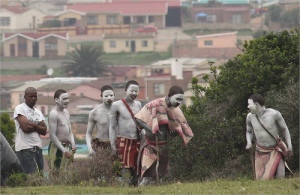

00:05 Publié dans Traditions | Lien permanent | Commentaires (0) | Tags : xhosa, traditions, zwarte piet, iran |  |
|  del.icio.us |
del.icio.us |  |
|  Digg |
Digg | ![]() Facebook
Facebook



